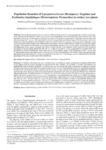Use este identificador para citar ou linkar para este item:
http://www.alice.cnptia.embrapa.br/alice/handle/doc/927246Registro completo de metadados
| Campo DC | Valor | Idioma |
|---|---|---|
| dc.contributor.author | SANTOS, R. S. | pt_BR |
| dc.contributor.author | COSTA, V. A. | pt_BR |
| dc.contributor.author | SILVA, J. M. | pt_BR |
| dc.contributor.author | FREITAS, S. | pt_BR |
| dc.date.accessioned | 2012-06-27T11:11:11Z | pt_BR |
| dc.date.available | 2012-06-27T11:11:11Z | pt_BR |
| dc.date.created | 2012-06-27 | pt_BR |
| dc.date.issued | 2012 | pt_BR |
| dc.identifier.citation | Revista Colombiana de Entomologia, v. 38, n. 2, p. 314-319, 2012. | pt_BR |
| dc.identifier.uri | http://www.alice.cnptia.embrapa.br/alice/handle/doc/927246 | pt_BR |
| dc.description | The tingid Leptopharsa heveae, known as the lace bug, occurs in large populations in rubber tree plantations, limiting the production of latex due to losses of photosynthetic area and weakening of the infested trees. The alternative for the use of insecticides would be the release of biological control agents, but little is known about the natural enemies of L. heveae. The parasitoid Erythmelus tingitiphagus parasitizes eggs of the lace bug in rubber tree plantations. The knowledge of the population dynamics and the peak of occurrence of economically important insect species and their natural enemies are indispensable requirements for the establishment of efficient and rational control strategies. The objective of this work was to study the population dynamics of L. heveae and E. tingitiphagus in rubber tree plantations in the county of Itiquira, MT, Brazil. Mature folioles were collected weekly from the lower stratum of the canopy of the tree clones RRIM 600, PR 255, GT 1, PB 235 and PB 217, from August/2005 to February/2006. The parasitoid was observed during the whole study period. The population peaks of the populations of the L. heveae and E. tingitiphagus in the study area occurred at the end of October and beginning of November. This result demonstrates that measures for the control of L. heveae and population increase of E. tingitiphagus must be adopted before the peak population of this pest in cultivated rubber plantations. | pt_BR |
| dc.language.iso | eng | eng |
| dc.rights | openAccess | eng |
| dc.subject | Rubber tree | pt_BR |
| dc.subject | Lace bugs | pt_BR |
| dc.subject | Chinche de encaje | pt_BR |
| dc.subject | Erythmelus tingitiphagus | pt_BR |
| dc.subject | Iquitira (MT) | pt_BR |
| dc.subject | Mato Grosso | pt_BR |
| dc.subject | Dinámica poblacional | pt_BR |
| dc.subject | Plagas de plantas | pt_BR |
| dc.title | Population dynamics of Leptopharsa heveae (Hemiptera: Tingidae) and Erythmelus tingitiphagus (Hymenoptera: Mymaridae) in rubber tree plants. | pt_BR |
| dc.type | Artigo de periódico | pt_BR |
| dc.date.updated | 2019-01-10T11:11:11Z | pt_BR |
| dc.subject.thesagro | Praga de planta | pt_BR |
| dc.subject.thesagro | Seringueira | pt_BR |
| dc.subject.thesagro | Hevea brasiliensis | pt_BR |
| dc.subject.thesagro | Mosca de renda | pt_BR |
| dc.subject.thesagro | Dinâmica populacional | pt_BR |
| dc.subject.thesagro | Caucho | pt_BR |
| dc.subject.thesagro | Percevejo de Renda | pt_BR |
| dc.subject.nalthesaurus | Plant pests | pt_BR |
| dc.subject.nalthesaurus | Tingidae | pt_BR |
| dc.subject.nalthesaurus | Population dynamics | pt_BR |
| dc.subject.nalthesaurus | Leptopharsa heveae | pt_BR |
| riaa.ainfo.id | 927246 | pt_BR |
| riaa.ainfo.lastupdate | 2019-01-10 -02:00:00 | pt_BR |
| dc.identifier.doi | http://hdl.handle.net/11449/41856 | pt_BR |
| dc.contributor.institution | RODRIGO SOUZA SANTOS, CPAF-AC; VALMIR A. COSTA, Instituto Biológico; JOAQUIM M. SILVA, UNEMAT; SÉRGIO FREITAS, UNESP. | pt_BR |
| Aparece nas coleções: | Artigo em periódico indexado (CPAF-AC)  | |
Arquivos associados a este item:
| Arquivo | Descrição | Tamanho | Formato | |
|---|---|---|---|---|
| 24301.pdf | 2,08 MB | Adobe PDF |  Visualizar/Abrir |









